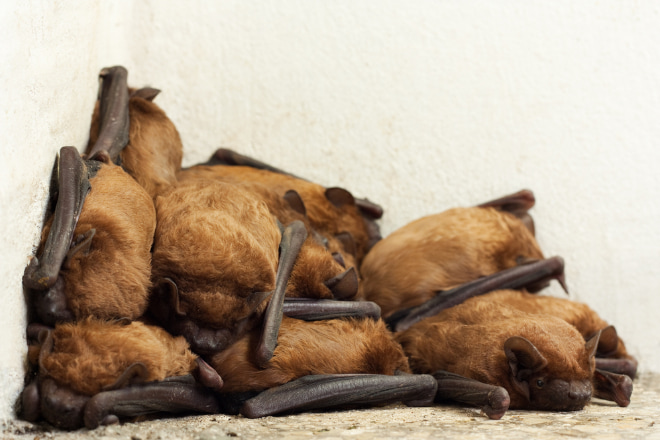Bats are unique in many regards. They perch upside down, use echolocation, and are the only mammals that fly. Bats are also associated with vampires and mentioned in dozens of folktales around the world. It comes as no surprise that bats have a unique reproduction cycle. If there are bats in your area, be sure to keep your distance and admire them from afar. These are protected, fascinating animals that cull thousands of mosquitoes per night, keeping us safe from Lyme disease and West Nile virus. Call Bat Control for humane removal and exclusion in southern Ontario.
Bats in Ontario breed in an unusual fashion. They mate in the fall, where several groups of bats will swarm together and have multiple partners. Then, instead of having their pups soon after their mating season, female bats hold onto their mates’ sperm and ovulate in the spring, about half a year later. After a gestation period of 50 to 60 days, female bats give birth to one pup each, sometime in June or July. Pups cling to their mothers and feed on their milk for about 4 weeks, after which they can fly and feed on their own.
Bats are vulnerable creatures that suffer disease and habitat loss, so it is important that they are not disturbed during their breeding season. Soon after their pups are weaned, they hibernate, making them difficult to remove from human habitats for most of the year. If bats have made themselves at home on your property, you may have to wait until the spring before you can have them removed. Contact a local wildlife removal professional for an inspection and humane removal plan. Bats in Canada are endangered and therefore it is illegal to do them any harm.
Why Do Bats Roost in Attics?
When hollowed trees, caves, and other naturally enclosed areas are scarce, bats turn to human-made alternatives, like attics. To get inside, they wriggle their way through gaps and cracks on the roof. Bats are quite small and can fit through holes barely half an inch wide. If you suspect that bats are roosting in your attic, look for a greasy opening in the siding of your home or somewhere along the edges of your soffits. If you can, take a look inside the attic and listen carefully. Look for droppings on the floor and little bats hiding between the rafters.
Contact a wildlife removal professional immediately if there are bats on your property. While they are interesting, endangered animals, bats do not belong in the home. These are potential carriers of the rabies virus, and their feces will seriously damage your attic. A professional will determine when it is safe to remove the animals and will evict them humanely with the use of a one-way door. The door will let the animals out but prevent their return, so they will find another place to roost. Call Bat Control for safe and guaranteed bat removal.
